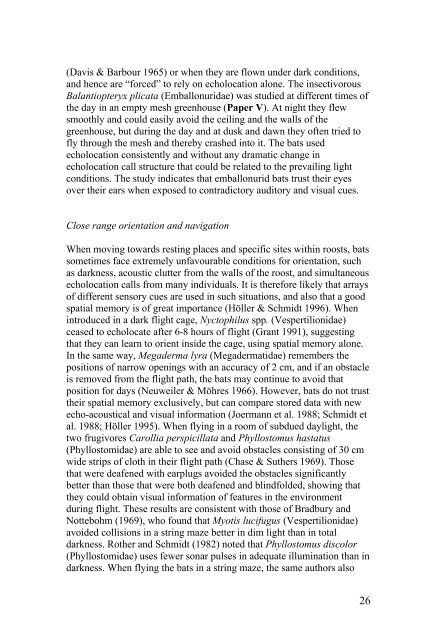Vision in echolocating bats - Fladdermus.net
Vision in echolocating bats - Fladdermus.net
Vision in echolocating bats - Fladdermus.net
Create successful ePaper yourself
Turn your PDF publications into a flip-book with our unique Google optimized e-Paper software.
(Davis & Barbour 1965) or when they are flown under dark conditions,<br />
and hence are “forced” to rely on echolocation alone. The <strong>in</strong>sectivorous<br />
Balantiopteryx plicata (Emballonuridae) was studied at different times of<br />
the day <strong>in</strong> an empty mesh greenhouse (Paper V). At night they flew<br />
smoothly and could easily avoid the ceil<strong>in</strong>g and the walls of the<br />
greenhouse, but dur<strong>in</strong>g the day and at dusk and dawn they often tried to<br />
fly through the mesh and thereby crashed <strong>in</strong>to it. The <strong>bats</strong> used<br />
echolocation consistently and without any dramatic change <strong>in</strong><br />
echolocation call structure that could be related to the prevail<strong>in</strong>g light<br />
conditions. The study <strong>in</strong>dicates that emballonurid <strong>bats</strong> trust their eyes<br />
over their ears when exposed to contradictory auditory and visual cues.<br />
Close range orientation and navigation<br />
When mov<strong>in</strong>g towards rest<strong>in</strong>g places and specific sites with<strong>in</strong> roosts, <strong>bats</strong><br />
sometimes face extremely unfavourable conditions for orientation, such<br />
as darkness, acoustic clutter from the walls of the roost, and simultaneous<br />
echolocation calls from many <strong>in</strong>dividuals. It is therefore likely that arrays<br />
of different sensory cues are used <strong>in</strong> such situations, and also that a good<br />
spatial memory is of great importance (Höller & Schmidt 1996). When<br />
<strong>in</strong>troduced <strong>in</strong> a dark flight cage, Nyctophilus spp. (Vespertilionidae)<br />
ceased to echolocate after 6-8 hours of flight (Grant 1991), suggest<strong>in</strong>g<br />
that they can learn to orient <strong>in</strong>side the cage, us<strong>in</strong>g spatial memory alone.<br />
In the same way, Megaderma lyra (Megadermatidae) remembers the<br />
positions of narrow open<strong>in</strong>gs with an accuracy of 2 cm, and if an obstacle<br />
is removed from the flight path, the <strong>bats</strong> may cont<strong>in</strong>ue to avoid that<br />
position for days (Neuweiler & Möhres 1966). However, <strong>bats</strong> do not trust<br />
their spatial memory exclusively, but can compare stored data with new<br />
echo-acoustical and visual <strong>in</strong>formation (Joermann et al. 1988; Schmidt et<br />
al. 1988; Höller 1995). When fly<strong>in</strong>g <strong>in</strong> a room of subdued daylight, the<br />
two frugivores Carollia perspicillata and Phyllostomus hastatus<br />
(Phyllostomidae) are able to see and avoid obstacles consist<strong>in</strong>g of 30 cm<br />
wide strips of cloth <strong>in</strong> their flight path (Chase & Suthers 1969). Those<br />
that were deafened with earplugs avoided the obstacles significantly<br />
better than those that were both deafened and bl<strong>in</strong>dfolded, show<strong>in</strong>g that<br />
they could obta<strong>in</strong> visual <strong>in</strong>formation of features <strong>in</strong> the environment<br />
dur<strong>in</strong>g flight. These results are consistent with those of Bradbury and<br />
Nottebohm (1969), who found that Myotis lucifugus (Vespertilionidae)<br />
avoided collisions <strong>in</strong> a str<strong>in</strong>g maze better <strong>in</strong> dim light than <strong>in</strong> total<br />
darkness. Rother and Schmidt (1982) noted that Phyllostomus discolor<br />
(Phyllostomidae) uses fewer sonar pulses <strong>in</strong> adequate illum<strong>in</strong>ation than <strong>in</strong><br />
darkness. When fly<strong>in</strong>g the <strong>bats</strong> <strong>in</strong> a str<strong>in</strong>g maze, the same authors also<br />
26


